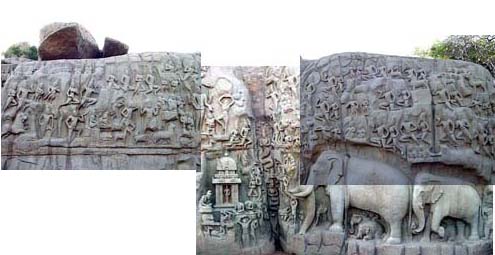Arjuna’s Penance
Let me narrate you two stories,
Arjuna, one of the Pandava brothers, in the great epic Mahabaratha performs severe austerities so that he could get his hands on Lord Shiva’s weapon. This gets more interesting as the lore says, one could obtain enough power to overcome even the gods by the way of self-mortification. So the gods, in order to save themselves, grant the proposal of the person who jeopardizes the supremacy of the gods.
The second story is the Ganges Story, in which the sage Bhagiratha performs austerities in order to bring the Ganges down to earth. Shiva had to consent to break her fall in his hair, because otherwise its force would be too great for the earth to contain.
This magnificent relief, Arjuna’s Penance, carved in the mid-seventh century, measures approximately 30m (100ft) long by 15m (45ft) high. The subject is either Arjuna’s Penance or the Descent of the Ganges, or possibly both. In India, logical alternatives are often conceptualized as “both-and” rather than “either-or.”
The composition of the relief includes the main elements of the story (left) and scenes of the natural and celestial worlds (right). A natural cleft populated by nagas separates the two halves of the relief. Water was poured down this cleft in order to simulate a natural waterfall (the Ganges’ descent). To the left, just above the shrine, Arjuna (or Bhagiratha) stands on one leg, his arms upraised, in a yoga posture. Behind him appears Shiva, holding a weapon and attended by ganas. To the right of the cleft, life-sized elephants protect their young below a scene of numerous other animals and flying celestials, all carved with the greatest vivacity, skill, naturalism, and joyousness.
This photograph cannot simply explain the greatness of this monument and I personally suggest you to pack your things to Mahabalipuram to visit this place.

